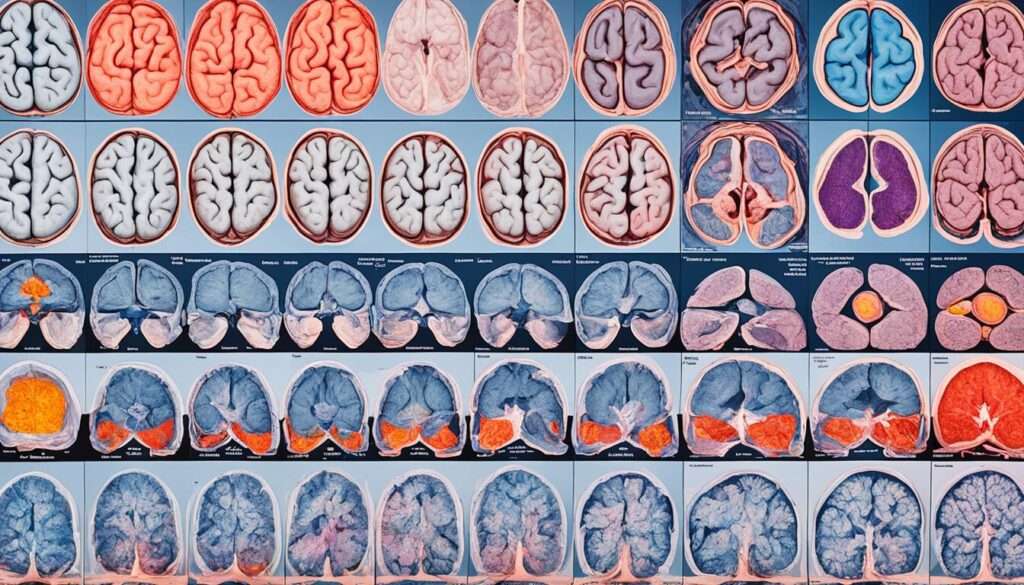Medically reviewed by Dr Chandril Chugh,
Renowned Neurologist and American Trained Specialist
Welcome to our comprehensive guide on understanding different types of brain tumors in adults. Here, we will explore the various tumor types that can develop in the adult brain, equipping you with the knowledge necessary to navigate the complexities of diagnosis and treatment options.
Table of Contents
TogglePrimary Brain Tumors
Primary brain tumors originate within the brain itself and can be classified as either benign (non-cancerous) or malignant (cancerous). Understanding the different types of primary brain tumors is crucial for accurate diagnosis and tailored treatment plans in adults.
There are several types of primary brain tumors seen in adults, each with its own distinct characteristics and treatment considerations:
Gliomas
Gliomas are the most common type of primary brain tumors in adults. These tumors originate from glial cells, which provide support and protection to the neurons in the brain. Gliomas can be further classified based on the specific type of glial cell they arise from, including:
- Astrocytomas: Arise from astrocytes, star-shaped cells that maintain the brain’s blood-brain barrier and provide structural support.
- Oligodendrogliomas: Develop from oligodendrocytes, which produce the myelin sheath that insulates nerve fibers.
- Ependymomas: Originate from ependymal cells that line the ventricles of the brain and spinal cord.
Meningiomas
Meningiomas are usually slow-growing tumors that arise from the meninges, the protective membranes that cover the brain and spinal cord. These tumors are more commonly found in women and are often benign. However, depending on their size and location, meningiomas can cause symptoms and require treatment.
Pituitary Tumors
Pituitary tumors develop in the pituitary gland, a small gland located at the base of the brain. These tumors can affect hormone production and may cause hormonal imbalances. Although most pituitary tumors are benign, they can still cause issues due to their size and effects on hormonal regulation.

| Tumor Type | Description |
|---|---|
| Gliomas | Arise from glial cells, including astrocytomas, oligodendrogliomas, and ependymomas. |
| Meningiomas | Develop from the meninges and are commonly found in women. |
| Pituitary Tumors | Form in the pituitary gland and can impact hormone production. |
Metastatic Brain Tumors
Metastatic brain tumors occur when cancer cells from other parts of the body spread to the brain. These secondary brain tumors are more common than primary brain tumors in adults, accounting for approximately 10 times more cases.
Various types of cancer can potentially metastasize to the brain, including:
- Lung cancer
- Breast cancer
- Colorectal cancer
- Renal cell carcinoma
- Melanoma
When cancer cells enter the bloodstream or lymphatic system, they can reach the brain and form secondary tumors. The ability of cancer cells to metastasize to the brain is influenced by factors such as the tumor’s aggressiveness, location, and the patient’s overall health.
Treatment options for metastatic brain tumors depend on factors such as the primary cancer type, the number and size of brain metastases, and the patient’s overall condition. Treatment may involve a combination of:
- Surgery: In some cases, surgical removal of the metastatic brain tumors may be possible, especially when there are single or a limited number of tumors.
- Radiation therapy: High-energy beams are used to target and destroy cancer cells in the brain, helping to alleviate symptoms and control tumor growth.
- Systemic therapy: Chemotherapy, targeted therapy, and immunotherapy drugs may be used to treat both the primary cancer and the metastatic brain tumors.
- Stereotactic radiosurgery: This non-invasive procedure delivers focused radiation to the brain tumors, precisely targeting them while sparing healthy tissue.

| Type of Cancer | Prevalence in Metastatic Brain Tumors |
|---|---|
| Lung cancer | 40-50% |
| Breast cancer | 15-20% |
| Colorectal cancer | 5-10% |
| Renal cell carcinoma | 5-10% |
| Melanoma | 5-10% |
Brain Tumor Grades and Stages
When it comes to brain tumors, understanding their grades and stages is essential for determining the appropriate treatment approach and predicting outcomes. The grading system helps classify tumors based on their aggressiveness, while the staging system provides insights into the extent of tumor growth and spread. Let’s delve into the different grades and stages of brain tumors to gain a deeper understanding of their significance.
Brain Tumor Grades
Brain tumor grades categorize tumors based on their cellular characteristics and how they behave. The World Health Organization (WHO) grading system is commonly used and classifies brain tumors into four grades:
- Grade I (Low-grade): These tumors are typically slow-growing and less likely to spread. They are usually benign and have well-defined borders. Surgery often provides a curative treatment.
- Grade II (Low-grade): These tumors are also relatively slow-growing but have infiltrative qualities, making complete removal more challenging. While they are classified as low-grade, their potential to progress to higher grades cannot be ignored.
- Grade III (High-grade): These tumors are more aggressive and tend to grow rapidly. They have an increased tendency to infiltrate nearby brain tissue. Prompt treatment, including surgery followed by radiation and chemotherapy, is crucial.
- Grade IV (High-grade): These tumors are the most aggressive and exhibit rapid growth and extensive infiltration. They are malignant and have the highest likelihood of recurrence. Treatment usually involves surgery, radiation therapy, and chemotherapy.
It’s important to note that the grading system helps healthcare professionals determine the tumor’s aggressiveness but does not provide information about its location or spread within the brain.
Brain Tumor Stages
While brain tumor grades classify tumors based on their aggressiveness, staging provides insights into the tumor’s size, extent of growth, and spread. Staging is crucial for determining the appropriate treatment strategy and predicting prognosis.
The staging of brain tumors is generally assessed using imaging techniques like MRI or CT scans. However, unlike other types of cancer, brain tumors do not have a standardized staging system.
Instead, brain tumor staging is usually determined by considering factors such as:
- The tumor’s size and location within the brain
- Extent of tumor infiltration into nearby brain tissues
- Presence of tumors in distant parts of the brain or other regions of the body if the tumor is metastatic
Hence, brain tumor staging varies based on the individual case and the specific tumor type. Healthcare professionals consider factors such as tumor size, location, and presence of any distant metastases to determine an appropriate treatment plan.
Understanding the grades and stages of brain tumors is critical for both healthcare professionals and patients. It helps guide treatment decisions, predict prognosis, and support informed discussions about the best course of action. Now, let’s move on to the next section to explore the symptoms and diagnosis of brain tumors.

Symptoms and Diagnosis of Brain Tumors
Recognizing the symptoms of brain tumors is the first step towards a timely diagnosis and effective treatment. While the specific symptoms can vary depending on the type, size, and location of the tumor, there are common signs to watch out for.
- Headaches: Persistent headaches, especially when accompanied by nausea and vomiting, can be a potential indicator of a brain tumor.
- Seizures: Unexplained seizures or convulsions can be a warning sign of abnormal brain activity caused by a tumor.
- Changes in vision: Blurred vision, double vision, or loss of peripheral vision are symptoms that may suggest a brain tumor affecting the optic nerves or regions of the brain responsible for vision.
- Balance and coordination problems: Difficulties with balance, coordination, and walking may be attributed to a tumor affecting specific areas of the brain responsible for motor function.
- Cognitive and personality changes: Memory problems, confusion, personality changes, and difficulty concentrating can occur when a tumor affects the cognitive and emotional centers of the brain.
- Speech and hearing difficulties: Impaired speech, difficulty understanding or processing language, and hearing loss may be signs of a brain tumor in areas responsible for communication.
If you experience any of these symptoms persistently or notice a combination of them, it is important to consult a healthcare professional for a thorough evaluation. A timely diagnosis is crucial for initiating the appropriate treatment and managing the condition effectively.
Diagnosing Brain Tumors
Diagnosing a brain tumor typically involves the following steps:
- Medical history and physical examination: The doctor will inquire about your symptoms, medical history, and perform a neurological examination to assess your motor skills, reflexes, and cognitive function.
- Imaging tests: Imaging techniques like magnetic resonance imaging (MRI) and computed tomography (CT) scans are essential for visualizing the brain and detecting any abnormal growths or tumors.
- Biopsy: In some cases, a small sample of the tumor tissue may need to be extracted for further analysis. This procedure is known as a biopsy and helps determine the tumor’s nature (benign or malignant) and specific cell types.
- Laboratory tests: Blood tests can help rule out other possible causes for the symptoms and provide additional insights into the overall health of the patient.
Once a brain tumor diagnosis is confirmed, further tests may be conducted to determine its grade, stage, and genetic characteristics. This information plays a crucial role in guiding treatment decisions and devising an individualized care plan.
Remember, early detection and timely intervention can significantly improve the prognosis and quality of life for individuals affected by brain tumors. If you experience any concerning symptoms, consult your healthcare provider promptly for an accurate diagnosis and appropriate treatment.
Treatment Options for Adult Brain Tumors
When it comes to treating adult brain tumors, there are a variety of options available. The choice of treatment depends on factors such as the type and grade of the tumor, as well as its location and size. It is essential to customize the treatment plan to cater to each individual’s specific needs.
Surgery: Surgery is often the first-line treatment for many brain tumors. The aim is to remove as much of the tumor as possible while preserving normal brain tissue. Advances in surgical techniques, such as navigational systems and intraoperative MRI, allow for more precise and effective tumor resection.
Radiation Therapy: Radiation therapy utilizes high-energy beams to target and destroy cancer cells. It is often used after surgery or as the main treatment for tumors that cannot be surgically removed. Techniques such as stereotactic radiosurgery and proton therapy offer highly targeted radiation, minimizing damage to surrounding healthy tissue.
Chemotherapy and Targeted Therapies: Chemotherapy involves using drugs to kill cancer cells. Targeted therapies, on the other hand, aim to block specific molecules responsible for tumor growth. Both approaches can be used alone or in combination with other treatments, offering additional options for managing adult brain tumors.
FAQ
What are the different types of brain tumors that can develop in adults?
The various types of brain tumors that can develop in adults include gliomas, meningiomas, pituitary tumors, and metastatic brain tumors.
What are primary brain tumors?
Primary brain tumors originate within the brain itself and can be either benign (non-cancerous) or malignant (cancerous).
What are the common types of primary brain tumors seen in adults?
Common types of primary brain tumors seen in adults include gliomas, meningiomas, and pituitary tumors.
What are metastatic brain tumors?
Metastatic brain tumors occur when cancer cells from other parts of the body spread to the brain.
Which types of cancer can metastasize to the brain?
Different types of cancer can metastasize to the brain, including lung cancer, breast cancer, colon cancer, and melanoma.
How are metastatic brain tumors managed?
The management of metastatic brain tumors involves various treatment options, including surgery, radiation therapy, and systemic therapy.
What is the significance of brain tumor grades and stages?
Brain tumor grades and stages play a crucial role in determining the severity of the tumor and guiding treatment decisions.
How are brain tumors graded and staged?
Brain tumors are graded based on their appearance under a microscope, and their stages are determined by factors such as tumor size and spread.
What are the common symptoms of brain tumors in adults?
Common symptoms of brain tumors in adults include headaches, seizures, cognitive changes, and neurological deficits.
How are brain tumors diagnosed?
Brain tumors are diagnosed through various methods, including imaging tests like MRI and CT scans, brain biopsies, and neurological examinations.
What treatment options are available for adult brain tumors?
Treatment options for adult brain tumors include surgery, radiation therapy, chemotherapy, targeted therapies, and supportive care.

Dr Chandril Chugh
Dr. Chandril Chugh is a U.S.-trained neurologist with over a decade of experience. Known for his compassionate care, he specializes in treating neurological conditions such as migraines, epilepsy, and Parkinson’s disease. Dr. Chugh is highly regarded for his patient-centered approach and dedication to providing personalized care.




